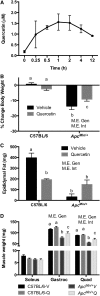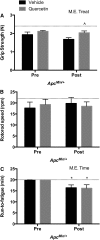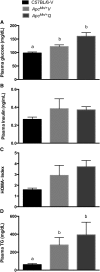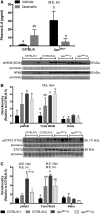Quercetin supplementation attenuates the progression of cancer cachexia in ApcMin/+ mice
- PMID: 24759931
- PMCID: PMC4018949
- DOI: 10.3945/jn.113.188367
Quercetin supplementation attenuates the progression of cancer cachexia in ApcMin/+ mice
Abstract
Although there are currently no approved treatments for cancer cachexia, there is an intensified interest in developing therapies because of the high mortality index associated with muscle wasting diseases. Successful treatment of the cachectic patient focuses on improving or maintaining body weight and musculoskeletal function. Nutraceutical compounds, including the natural phytochemical quercetin, are being examined as potential treatments because of their anti-inflammatory, antioxidant, and anticarcinogenic properties. The purpose of this study was to determine the effect of quercetin supplementation on the progression of cachexia in the adenomatous polyposis coli (Apc)(Min/+) mouse model of colorectal cancer. At 15 wk of age, C57BL/6 and male Apc(Min/+) mice were supplemented with 25 mg/kg of quercetin or vehicle solution mix of Tang juice and water (V) daily for 3 wk. Body weight, strength, neuromuscular performance, and fatigue were assessed before and after quercetin or V interventions. Indicators of metabolic dysfunction and inflammatory signaling were also assessed. During the treatment period, the relative decrease in body weight in the Apc(Min/+) mice gavaged with V (Apc(Min/+)V; -14% ± 2.3) was higher than in control mice gavaged with V (+0.6% ± 1.0), control mice gavaged with quercetin (-2% ± 1.0), and Apc(Min/+) mice gavaged with quercetin (Apc(Min/+)Q; -9% ± 1.3). At 18 wk of age, the loss of grip strength and muscle mass shown in Apc(Min/+)V mice was significantly attenuated (P < 0.05) in Apc(Min/+)Q mice. Furthermore, Apc(Min/+)V mice had an induction of plasma interleukin-6 and muscle signal transducer and activator of transcription 3 phosphorylation, which were significantly (P < 0.05) mitigated in Apc(Min/+)Q mice, despite having a similar tumor burden. Quercetin treatment did not improve treadmill run-time-to-fatigue, hyperglycemia, or hyperlipidemia in cachectic Apc(Min/+) mice. Overall, quercetin supplementation positively affected several aspects of cachexia progression in mice and warrants further exploration as a potential anticachectic therapeutic.
© 2014 American Society for Nutrition.
Conflict of interest statement
Author disclosures: K. T. Velázquez, R. T. Enos, A. A. Narsale, M. J. Puppa, J. M. Davis, E. A. Murphy, and J. A. Carson, no conflicts of interest.
Figures




References
-
- Fearon K, Strasser F, Anker SD, Bosaeus I, Bruera E, Fainsinger RL, Jatoi A, Loprinzi C, MacDonald N, Mantovani G, http://www.ncbi.nlm.nih.gov/pubmed?term=Davis%20M%5BAuthor%5D&cauthor=tr...et al. Definition and classification of cancer cachexia: an international consensus. Lancet Oncol. 2011;12:489–95. - PubMed
-
- Dewys WD, Begg C, Lavin PT, Band PR, Bennett JM, Bertino JR, Cohen MH, Douglass HO Jr., Engstrom PF, Ezdinli EZ, http://www.ncbi.nlm.nih.gov/pubmed?term=Horton%20J%5BAuthor%5D&cauthor=t...et al. Prognostic effect of weight loss prior to chemotherapy in cancer patients. Eastern Cooperative Oncology Group. Am J Med. 1980;69:491–7. - PubMed
-
- Moser AR, Pitot HC, Dove WF. A dominant mutation that predisposes to multiple intestinal neoplasia in the mouse. Science. 1990;247:322–4. - PubMed
-
- Powell SM, Zilz N, Beazer-Barclay Y, Bryan TM, Hamilton SR, Thibodeau SN, Vogelstein B, Kinzler KW. APC mutations occur early during colorectal tumorigenesis. Nature. 1992;359:235–7. - PubMed
-
- McCart AE, Vickaryous NK, Silver A. Apc mice: models, modifiers and mutants. Pathol Res Pract. 2008;204:479–90. - PubMed
Publication types
MeSH terms
Substances
Grants and funding
LinkOut - more resources
Full Text Sources
Other Literature Sources
Medical

